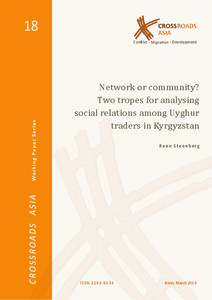Steenberg, Rune: Network or Community? Two tropes for analysing social relations among Uyghur traders in Kyrgyzstan. Bonn: Competence Network Crossroads Asia: Conflict – Migration – Development, 2014. In: Baldauf, Ingeborg; Conermann, Stephan; Kreutzmann, Hermann; Nadjmabadi, Shahnaz; Reetz, Dietrich; Schetter, Conrad; Sökefeld, Martin; Hornidge, Anna-Katharina (Hrsg.): Crossroads Asia Working Paper Series, 18.
Online-Ausgabe in bonndoc: https://hdl.handle.net/20.500.11811/145
Online-Ausgabe in bonndoc: https://hdl.handle.net/20.500.11811/145
@techreport{handle:20.500.11811/145,
author = {{Rune Steenberg}},
editor = {{Ingeborg Baldauf} and {Stephan Conermann} and {Hermann Kreutzmann} and {Shahnaz Nadjmabadi} and {Dietrich Reetz} and {Conrad Schetter} and {Martin Sökefeld} and {Anna-Katharina Hornidge}},
title = {Network or Community? Two tropes for analysing social relations among Uyghur traders in Kyrgyzstan},
publisher = {Competence Network Crossroads Asia: Conflict – Migration – Development},
year = 2014,
month = mar,
series = {Crossroads Asia Working Paper Series},
volume = 18,
note = {This article focuses on Uyghur traders from rural Atush trading in southern Kyrgyzstan, more precisely in Kadamjay in Batken. People from Atush are known to be especially gifted in trade across all of Xinjiang and Central Asia. The local idiom projects these features into the person, the atushliq sodigher (tradesman from Atush; cf. Raxman et al. 2008: 227-230), but a social science perspective recommends us to seek the explanation for them in the social environment and the social relations it facilitates. It is my proposition that these Atush traders’ success in trading enterprises is closely connected to their social relations (cf. Tilly 2005: 1-17), and that important elements of these social relations are better described using the analytical concept of ‘community’ than that of ‘network’. Finally, it is my proposition that ‘community’ and ‘network’ are not categories of social organisation according to which certain empirical examples can be classified, but rather provide analytical tools with which to access different aspects of social institutions of lasting personal relations in Central Asia and should therefore be seen not as alternative but as complementary tropes. This paper aims to design an analytical tool for approaching such social relations and social institutions of close permanent social interaction in Central Asia (and possibly beyond); a tool comprised of the mutually complementing identification of network-aspects and community-aspects of these. By using the terms ‘network-aspects’ and ‘community-aspects’ instead of identifying ‘networks’ and ‘communities’ I am deliberately not striving at any classification of social institutions into exclusively ‘networks’ or ‘communities’. I employ the analytical metaphors ‘network’ and ‘community’ in a complementary, not mutually exclusive manner. The analytical approaches behind ‘network’ and ‘community’ respectively pose many similar questions and treat many similar phenomena. But they formulate them in a different idiom, within a different metaphorical frame. This different metaphoric has different connotations and holds different analytical possibilities. Each metaphor is, as Max Black has put it, but the peak of a sunken (analytical) model (1996: 396) and these two models can profitably be applied as complementary tools.},
url = {https://hdl.handle.net/20.500.11811/145}
}
author = {{Rune Steenberg}},
editor = {{Ingeborg Baldauf} and {Stephan Conermann} and {Hermann Kreutzmann} and {Shahnaz Nadjmabadi} and {Dietrich Reetz} and {Conrad Schetter} and {Martin Sökefeld} and {Anna-Katharina Hornidge}},
title = {Network or Community? Two tropes for analysing social relations among Uyghur traders in Kyrgyzstan},
publisher = {Competence Network Crossroads Asia: Conflict – Migration – Development},
year = 2014,
month = mar,
series = {Crossroads Asia Working Paper Series},
volume = 18,
note = {This article focuses on Uyghur traders from rural Atush trading in southern Kyrgyzstan, more precisely in Kadamjay in Batken. People from Atush are known to be especially gifted in trade across all of Xinjiang and Central Asia. The local idiom projects these features into the person, the atushliq sodigher (tradesman from Atush; cf. Raxman et al. 2008: 227-230), but a social science perspective recommends us to seek the explanation for them in the social environment and the social relations it facilitates. It is my proposition that these Atush traders’ success in trading enterprises is closely connected to their social relations (cf. Tilly 2005: 1-17), and that important elements of these social relations are better described using the analytical concept of ‘community’ than that of ‘network’. Finally, it is my proposition that ‘community’ and ‘network’ are not categories of social organisation according to which certain empirical examples can be classified, but rather provide analytical tools with which to access different aspects of social institutions of lasting personal relations in Central Asia and should therefore be seen not as alternative but as complementary tropes. This paper aims to design an analytical tool for approaching such social relations and social institutions of close permanent social interaction in Central Asia (and possibly beyond); a tool comprised of the mutually complementing identification of network-aspects and community-aspects of these. By using the terms ‘network-aspects’ and ‘community-aspects’ instead of identifying ‘networks’ and ‘communities’ I am deliberately not striving at any classification of social institutions into exclusively ‘networks’ or ‘communities’. I employ the analytical metaphors ‘network’ and ‘community’ in a complementary, not mutually exclusive manner. The analytical approaches behind ‘network’ and ‘community’ respectively pose many similar questions and treat many similar phenomena. But they formulate them in a different idiom, within a different metaphorical frame. This different metaphoric has different connotations and holds different analytical possibilities. Each metaphor is, as Max Black has put it, but the peak of a sunken (analytical) model (1996: 396) and these two models can profitably be applied as complementary tools.},
url = {https://hdl.handle.net/20.500.11811/145}
}






